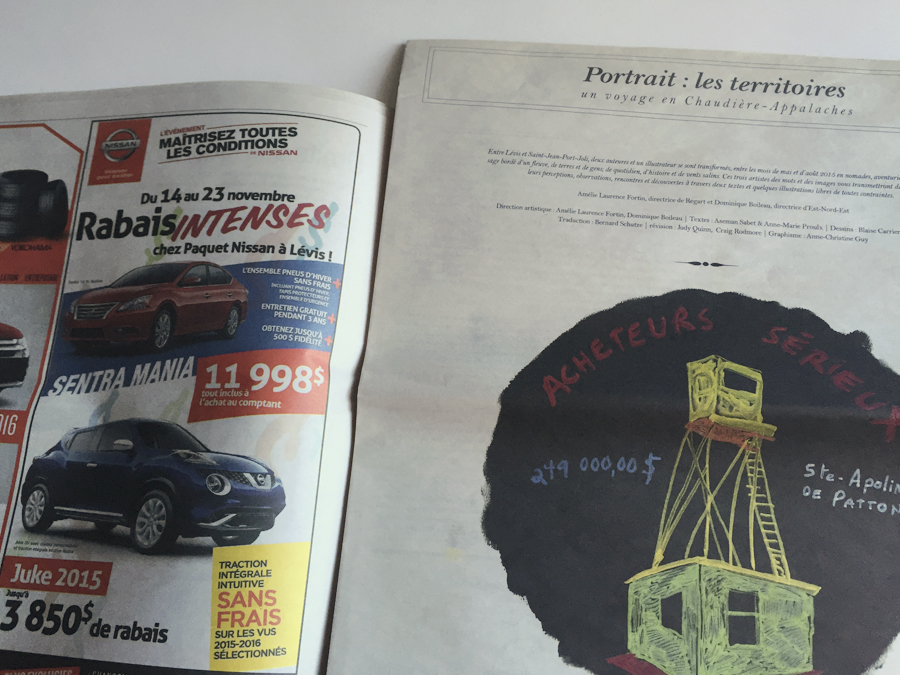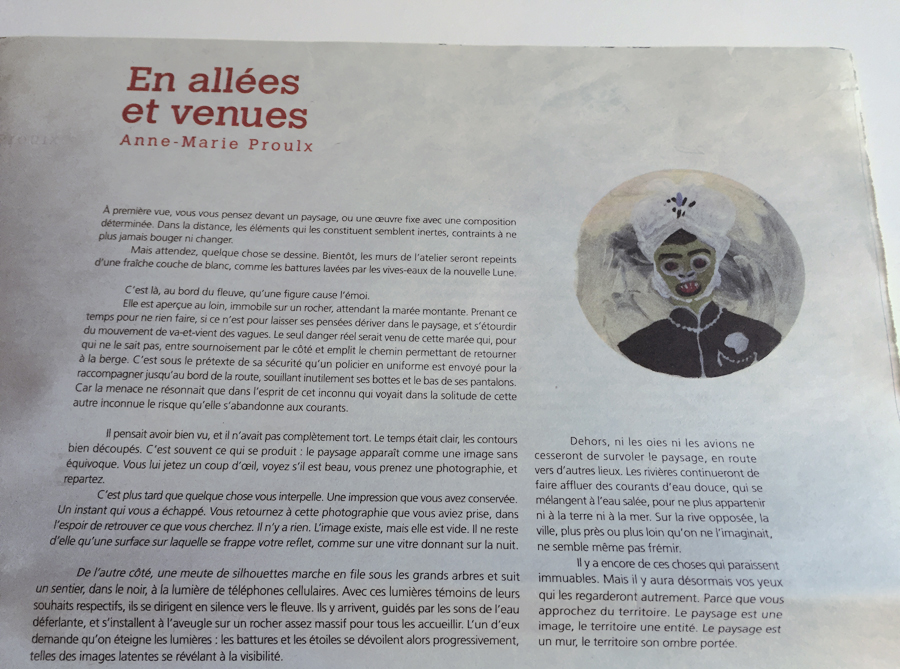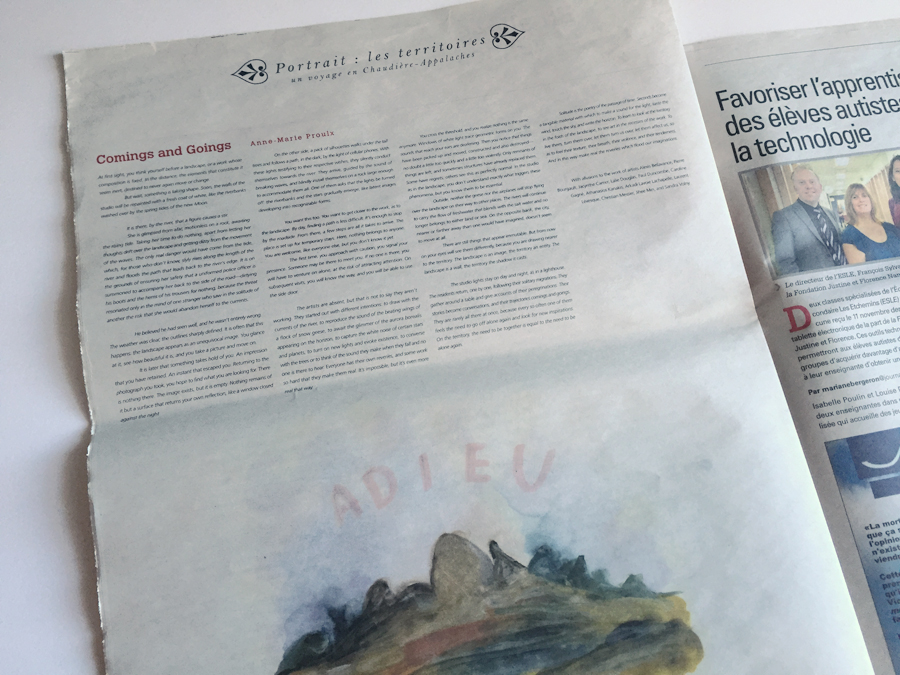« Comings and Goings »
2015
Text published in Portrait : les territoires, a publication inserted in the Journal de Lévis and the Journal coopératif L'Oie blanche. A project by Regart and Est-Nord-Est.
Portrait : les territoires
Artistic Direction: Amélie Laurence Fortin, Dominique Boileau | Texts: Aseman Sabet, Anne-Marie Proulx | Illustrations: Blaise Carrier-Chouinard | Translation: Bernard Schutze, Craig Rodmore | Revision: Judy Quinn, Craig Rodmore | Graphic Design: Anne-Christine Guy

Comings and Goings
At first sight, you think yourself before a landscape, or a work whose composition is fixed. In the distance, the elements that constitute it seem inert, destined to never again move or change.
But wait, something is taking shape. Soon, the walls of the studio will be repainted with a fresh coat of white, like the riverbanks washed over by the spring tides of the new Moon.
It is there, by the river, that a figure causes a stir.
She is glimpsed from afar, motionless on a rock, awaiting the rising tide. Taking her time to do nothing, apart from letting her thoughts drift over the landscape and getting dizzy from the movement of the waves. The only real danger would have come from the tide, which, for those who don’t know, slyly rises along the length of the river and floods the path that leads back to the river’s edge. It is on the grounds of ensuring her safety that a uniformed police officer is summoned to accompany her back to the side of the road–dirtying his boots and the hems of his trousers for nothing, because the threat resonated only in the mind of one stranger who saw in the solitude of another the risk that she would abandon herself to the currents.
He believed he had seen well, and he wasn’t entirely wrong. The weather was clear, the outlines sharply defined. It is often that this happens: the landscape appears as an unequivocal image. You glance at it, see how beautiful it is, and you take a picture and move on. It is later that something takes hold of you. An impression that you have retained. An instant that escaped you. Returning to the photograph you took, you hope to find what you are looking for. There is nothing there. The image exists, but it is empty. Nothing remains of it but a surface that returns your own reflection, like a window closed against the night.
On the other side, a pack of silhouettes walks under the tall trees and follows a path, in the dark, by the light of cellular phones. With these lights testifying to their respective wishes, they silently conduct themselves towards the river. They arrive, guided by the sound of breaking waves, and blindly install themselves on a rock large enough to accommodate them all. One of them asks that the lights be turned off: the riverbanks and the stars gradually emerge, like latent images developing into recognizable forms.
You want this too. You want to get closer to the work, as to the landscape. By day, finding a path is less difficult. It’s enough to stop by the roadside. From there, a few steps are all it takes to arrive. The place is set up for temporary stays. Here, nothing belongs to anyone. You are welcome, like everyone else, but you don’t know it yet.
The first time, you approach with caution, you signal your presence. Someone may be there to meet you. If no one is there, you will have to venture on alone, at the risk of attracting attention. On subsequent visits, you will know the way, and you will be able to use the side door.
The artists are absent, but that is not to say they aren’t working. They started out with different intentions: to draw with the currents of the river, to reproduce the sound of the beating wings of a flock of snow geese, to await the glimmer of the aurora borealis appearing on the horizon, to capture the white noise of certain stars and planets, to turn on new lights and evoke existence, to converse with the trees or to think of the sound they make when they fall and no one is there to hear. Everyone has their own reveries, and some work so hard that they make them real. It’s impossible, but it’s even more real that way.
You cross the threshold, and you realize nothing is the same anymore. Windows of white light trace geometric forms on you. The sounds that reach your ears are deafening. Then you notice that things have been picked up and moved, constructed and also destroyed–no doubt a little too quickly and a little too violently. Only remnants of things are left, and sometimes structures have already replaced them. Some have regrets, others see this as perfectly normal. In the studio as in the landscape, you don’t understand exactly what triggers these phenomena, but you know them to be essential.
Outside, neither the geese nor the airplanes will stop flying over the landscape on their way to other places. The rivers will continue to carry the flow of freshwater that blends with the salt water and no longer belongs to either land or sea. On the opposite bank, the city, nearer or farther away than one would have imagined, doesn’t seem to move at all.
There are still things that appear immutable. But from now on your eyes will see them differently, because you are drawing nearer to the territory. The landscape is an image, the territory an entity. The landscape is a wall, the territory the shadow it casts.
In the studio, the lights stay on day and night, as in a lighthouse. The residents return, one by one, following their solitary migrations. They gather around a table and give accounts of their peregrinations. Their stories become conversations, and their trajectories comings and goings.
They are rarely all there at once, because every so often one of them feels the need to go off alone again and look for new inspirations.
On the territory, the need to be together is equal to the need to be alone again.
Solitude is the poetry of the passage of time. Seconds become a tangible material with which to make a sound for the light, taste the wind, touch the sky, and write the horizon. To learn to look at the territory in the folds of the landscape, to see art in the recesses of the work. To live them, turn them over, let them turn us over, let them affect us, so as to feel their texture, their breath, their violence, and their tenderness. And in this way make real the reveries which flood our imaginations.
With allusions to the work of artists Alexis Bellavance, Pierre Bourgault, Jacynthe Carrier, Lalie Douglas, Paul Duncombe, Caroline Gagné, Athanasios Kanakis, Arkadi Lavoie Lachapelle, Laurent Lévesque, Christian Messier, Jihee Min, and Sandra Volny.


2015
Text published in Portrait : les territoires, a publication inserted in the Journal de Lévis and the Journal coopératif L'Oie blanche. A project by Regart and Est-Nord-Est.
Portrait : les territoires
Artistic Direction: Amélie Laurence Fortin, Dominique Boileau | Texts: Aseman Sabet, Anne-Marie Proulx | Illustrations: Blaise Carrier-Chouinard | Translation: Bernard Schutze, Craig Rodmore | Revision: Judy Quinn, Craig Rodmore | Graphic Design: Anne-Christine Guy

Comings and Goings
At first sight, you think yourself before a landscape, or a work whose composition is fixed. In the distance, the elements that constitute it seem inert, destined to never again move or change.
But wait, something is taking shape. Soon, the walls of the studio will be repainted with a fresh coat of white, like the riverbanks washed over by the spring tides of the new Moon.
It is there, by the river, that a figure causes a stir.
She is glimpsed from afar, motionless on a rock, awaiting the rising tide. Taking her time to do nothing, apart from letting her thoughts drift over the landscape and getting dizzy from the movement of the waves. The only real danger would have come from the tide, which, for those who don’t know, slyly rises along the length of the river and floods the path that leads back to the river’s edge. It is on the grounds of ensuring her safety that a uniformed police officer is summoned to accompany her back to the side of the road–dirtying his boots and the hems of his trousers for nothing, because the threat resonated only in the mind of one stranger who saw in the solitude of another the risk that she would abandon herself to the currents.
He believed he had seen well, and he wasn’t entirely wrong. The weather was clear, the outlines sharply defined. It is often that this happens: the landscape appears as an unequivocal image. You glance at it, see how beautiful it is, and you take a picture and move on. It is later that something takes hold of you. An impression that you have retained. An instant that escaped you. Returning to the photograph you took, you hope to find what you are looking for. There is nothing there. The image exists, but it is empty. Nothing remains of it but a surface that returns your own reflection, like a window closed against the night.
On the other side, a pack of silhouettes walks under the tall trees and follows a path, in the dark, by the light of cellular phones. With these lights testifying to their respective wishes, they silently conduct themselves towards the river. They arrive, guided by the sound of breaking waves, and blindly install themselves on a rock large enough to accommodate them all. One of them asks that the lights be turned off: the riverbanks and the stars gradually emerge, like latent images developing into recognizable forms.
You want this too. You want to get closer to the work, as to the landscape. By day, finding a path is less difficult. It’s enough to stop by the roadside. From there, a few steps are all it takes to arrive. The place is set up for temporary stays. Here, nothing belongs to anyone. You are welcome, like everyone else, but you don’t know it yet.
The first time, you approach with caution, you signal your presence. Someone may be there to meet you. If no one is there, you will have to venture on alone, at the risk of attracting attention. On subsequent visits, you will know the way, and you will be able to use the side door.
The artists are absent, but that is not to say they aren’t working. They started out with different intentions: to draw with the currents of the river, to reproduce the sound of the beating wings of a flock of snow geese, to await the glimmer of the aurora borealis appearing on the horizon, to capture the white noise of certain stars and planets, to turn on new lights and evoke existence, to converse with the trees or to think of the sound they make when they fall and no one is there to hear. Everyone has their own reveries, and some work so hard that they make them real. It’s impossible, but it’s even more real that way.
You cross the threshold, and you realize nothing is the same anymore. Windows of white light trace geometric forms on you. The sounds that reach your ears are deafening. Then you notice that things have been picked up and moved, constructed and also destroyed–no doubt a little too quickly and a little too violently. Only remnants of things are left, and sometimes structures have already replaced them. Some have regrets, others see this as perfectly normal. In the studio as in the landscape, you don’t understand exactly what triggers these phenomena, but you know them to be essential.
Outside, neither the geese nor the airplanes will stop flying over the landscape on their way to other places. The rivers will continue to carry the flow of freshwater that blends with the salt water and no longer belongs to either land or sea. On the opposite bank, the city, nearer or farther away than one would have imagined, doesn’t seem to move at all.
There are still things that appear immutable. But from now on your eyes will see them differently, because you are drawing nearer to the territory. The landscape is an image, the territory an entity. The landscape is a wall, the territory the shadow it casts.
In the studio, the lights stay on day and night, as in a lighthouse. The residents return, one by one, following their solitary migrations. They gather around a table and give accounts of their peregrinations. Their stories become conversations, and their trajectories comings and goings.
They are rarely all there at once, because every so often one of them feels the need to go off alone again and look for new inspirations.
On the territory, the need to be together is equal to the need to be alone again.
Solitude is the poetry of the passage of time. Seconds become a tangible material with which to make a sound for the light, taste the wind, touch the sky, and write the horizon. To learn to look at the territory in the folds of the landscape, to see art in the recesses of the work. To live them, turn them over, let them turn us over, let them affect us, so as to feel their texture, their breath, their violence, and their tenderness. And in this way make real the reveries which flood our imaginations.
With allusions to the work of artists Alexis Bellavance, Pierre Bourgault, Jacynthe Carrier, Lalie Douglas, Paul Duncombe, Caroline Gagné, Athanasios Kanakis, Arkadi Lavoie Lachapelle, Laurent Lévesque, Christian Messier, Jihee Min, and Sandra Volny.

